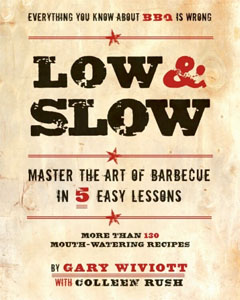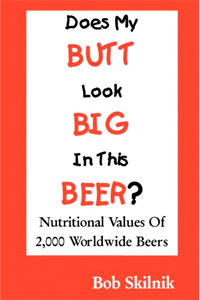| « Wanted: Your Cookie Genius | Great Sea = Great Chow » |
Feature Fri May 29 2009
Smoking and Drinking
With a grey and drizzly Memorial Day in our rearview mirrors, the official backyard -- or back deck alley, sidewalk, whathaveyou -- barbecue season is upon us. And sure, you could simply pull out the Weber and grill up some hotdogs and hamburgers. But if you really want to impress your friends, take it to the next level and start smoking -- meats, that is.
Getting Smoked
I know, you're probably thinking, doesn't that take a lot of specialized equipment? And anyway, I've never done it before, it'd probably turn out horribly. The answer to that first question is no, it doesn't require special equipment -- you could do it in that kettle of yours, assuming it's something larger than a Smokey Joe. And as for never having done it before, there's a new book to help teach you how: Low & Slow: Master the Art of Barbecue in 5 Easy Lessons, by Gary Wiviott and Colleen Rush.
 Wiviott, aka "G Wiv," is the founder of LTHForum, the Chicago-based culinary chat site, and a veteran pit master; Rush is a veteran food writer who professes to have known nothing about barbecue before this project. Together, they have turned Wiviott's popular online smoker tutorial -- which itself grew out of an email to a nephew -- and distilled it into five lessons that comprise a crash course in cooking with smoke, starting with marinated chicken and working up through brined chicken, baby back and short ribs and finally pulled pork. Lesson #1, Chicken Mojo Criollo, is available for download on the book's website.
Wiviott, aka "G Wiv," is the founder of LTHForum, the Chicago-based culinary chat site, and a veteran pit master; Rush is a veteran food writer who professes to have known nothing about barbecue before this project. Together, they have turned Wiviott's popular online smoker tutorial -- which itself grew out of an email to a nephew -- and distilled it into five lessons that comprise a crash course in cooking with smoke, starting with marinated chicken and working up through brined chicken, baby back and short ribs and finally pulled pork. Lesson #1, Chicken Mojo Criollo, is available for download on the book's website.
But first things first. Before even getting to the chicken, the authors take you through an equipment check, laying out exactly what you need for proper smoking. Wiviott is a big proponent of K.I.S.S. -- keep it simple, stupid -- and has unkind things to say about most of the gadgets and doodads you'll find in gourmet stores. All you really need is lump charcoal and newspaper, a chimney starter, some pans of water, and something to the the smoking in. Even thermometers are unnecessary in Wiviott's opinion, but he begrudgingly encourages you use one just to show you why you don't need it.
Most people don't have a top-of-the-line professional smoker, so there's information about the three primary consumer options: the Weber "Smokey Mountain" smoker, the offset smoker and the standard Weber kettle grill. The authors take time to explain the mechanics of the smoking process in each smoker type, and how to set up each for optimal cookery. They carry that info into each of the lessons, too, providing adjusted directions for each smoker format.
If all it was was the five lessons broken down for three smokers, it wouldn't be much of a book. Fortunately, there are a good number of recipes for marinades, brines. rubs and sauces for when you've mastered each lesson the simple way and are ready to start riffing. At the end of the book, there's even a chapter on sides to help round out your summer meal, as well as some additional smoking recipes for such things as fruit and oysters, and what to do with leftover smoked meat (if there is any).
Thanks to our prolonged and rainy spring, I've only been able to try out Lesson 1 from Low & Slow. Following the directions for my kettle grill, I ended up with some beautifully smoked chicken, with a light smokey flavor that permeated the meat without overpowering its natural flavor. I'm a step beyond an amateur, having done quite well cooking smoked brisket in the past, but I had no trouble following directions and I doubt someone with less experience than me would either. In fact, it might be an advantage, since you'd be more likely not to stray from Wiviott's recommendations. If there's a criticism I have of the book, it's that its "do as I say or else" taskmaster tone in the lessons could be a turnoff to some. The idea behind it is to get you to follow instructions until you know them by heart before going off and experimenting, but not everyone takes kindly to commands. However, it's easy to ignore the tone and just heed the solid guidance this book provides. I'm eager for a nice weekend to try my hand at some smoked baby back ribs -- Lesson 3.
What Are You Drinking?
Chances are you've seen commercials for MGD 64 and other ultra-low calorie beers, but have you ever noticed there's no nutritional information on beer? The Alcohol Tobacco Tax and Trade Bureau is working on labeling guidelines, but it may be years before you know what you're putting down. In the meantime, you have Bob Skilnik. A certified brewer and frequent writer on the subject, Skilnik has collected and compiled the nutritional information for more than 2,000 beers from around the world into a book, Does My Butt Look Big in This Beer?.
 This self-published book isn't bed-time reading -- aside from a short introduction explaining methodology and shedding a little light on why beer doesn't have all this stuff right on the bottle, it's just pages and pages of data. For every brand, you get serving size (12oz.), the number of carbs and calories, the alcohol by volume, and for dieters, the number of Weight Watchers points that beer will eat up. Both macro- and microbrews are covered, including Goose Island Brewery's full line.
This self-published book isn't bed-time reading -- aside from a short introduction explaining methodology and shedding a little light on why beer doesn't have all this stuff right on the bottle, it's just pages and pages of data. For every brand, you get serving size (12oz.), the number of carbs and calories, the alcohol by volume, and for dieters, the number of Weight Watchers points that beer will eat up. Both macro- and microbrews are covered, including Goose Island Brewery's full line.
While it's not exactly a page-turner, Does My Butt Look Big does yield some pretty interesting info. For instance, speaking of Goose Island, only three beers had higher numbers than their Bourbon County Stout (45 carbs, 415 calories, 13.5 percent alcohol by volume [ABV] and 8 Weight Watchers points): two high-alcohol beers from Avery Brewing and Boston Beer Company (aka Sam Adams) Utopia, which has an ABV of 27 percent and a whopping 732 calories -- that's up there with a Double Quarter Pounder with Cheese at McDonald's. (Bourbon County Stout is roughly equivalent to a regular Quarter Pounder and a couple fries.)
Even more interesting was the other end of the spectrum. There are only three beers in the entire book that only rate 1 Weight Watchers point that weren't also non-alcoholic: Beck's Light, MGD 64 and PBR Light. But Beck's Light and MGD 64 aren't just light on calories, they're light on alcohol, weighing in at 2.3 percent and 2.8 percent ABV respectively. Most beers are in the 4-5 percent ABV range, which means you'll need to drink two MGD 64s to every one regular MGD to feel the same effects -- thereby eliminating any diet effects. In comparison, PBR Light is 3.9 percent ABV and still only 72 calories (though it's double or triple the carbs of the other two).
I'm not sure Does My Butt Look Big in This Beer? is a book everyone should run out and buy, but if you're trying to work on your figure or just trying to avoid growing the beer gut any further this summer, it might be worth spending the $10 for a copy. At the very least, every bar in the city ought to have it on hand as a reference for customers.
Both of these books come accompanied by rich and informative websites, and in the case of the beer book, a great blog about drinking healthy, too.









Bob Skilnik / May 29, 2009 6:26 PM
C'mon Andy. Everybody in the world should go out a buy a copy of the book! 3 copies!!
It really should, however, be a fixture in every bar to at least answer questions like what beer's the strongest? the weakest? has the most calories/carbs?